Implementing ITIL Service Lifecycle for a New Enrollment System
VerifiedAdded on 2023/03/30
|16
|3654
|476
AI Summary
This article discusses the implementation of ITIL service lifecycle for a new enrollment system in a university. It highlights the importance of ITIL in enhancing business efficiency, reducing costs, minimizing service downtime, improving decision making, increasing customer satisfaction, and meeting the needs of the university. The article also provides an overview of the ITIL service lifecycle stages and the benefits of implementing ITIL in the development of the new system.
Contribute Materials
Your contribution can guide someone’s learning journey. Share your
documents today.

Running head: ITIL SERVICE LIFECYCLE
ITIL SERVICE LIFECYCLE- ASSIGNMENT 2
Name of the Student
Name of the University
Author Note
ITIL SERVICE LIFECYCLE- ASSIGNMENT 2
Name of the Student
Name of the University
Author Note
Secure Best Marks with AI Grader
Need help grading? Try our AI Grader for instant feedback on your assignments.
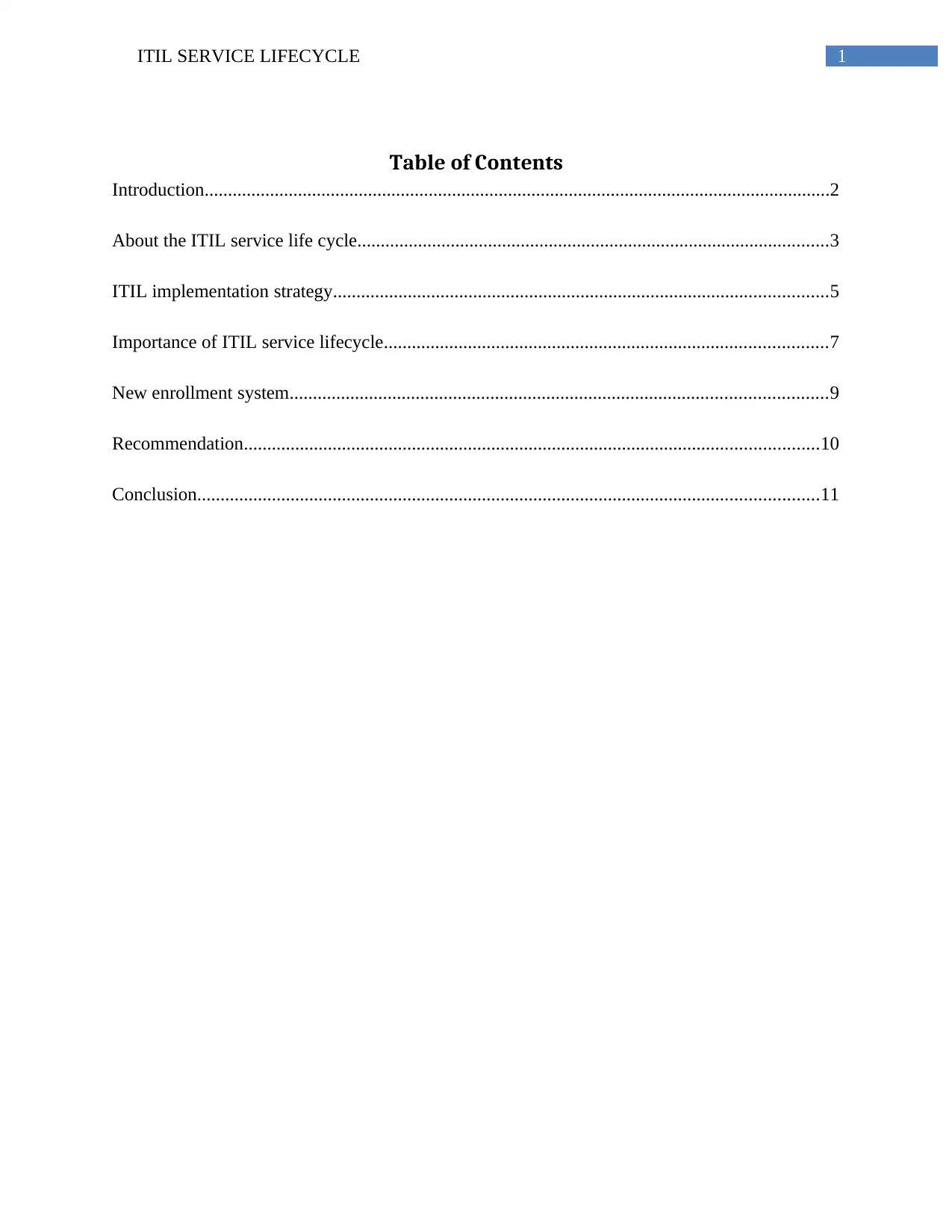
1ITIL SERVICE LIFECYCLE
Table of Contents
Introduction......................................................................................................................................2
About the ITIL service life cycle.....................................................................................................3
ITIL implementation strategy..........................................................................................................5
Importance of ITIL service lifecycle...............................................................................................7
New enrollment system...................................................................................................................9
Recommendation...........................................................................................................................10
Conclusion.....................................................................................................................................11
Table of Contents
Introduction......................................................................................................................................2
About the ITIL service life cycle.....................................................................................................3
ITIL implementation strategy..........................................................................................................5
Importance of ITIL service lifecycle...............................................................................................7
New enrollment system...................................................................................................................9
Recommendation...........................................................................................................................10
Conclusion.....................................................................................................................................11
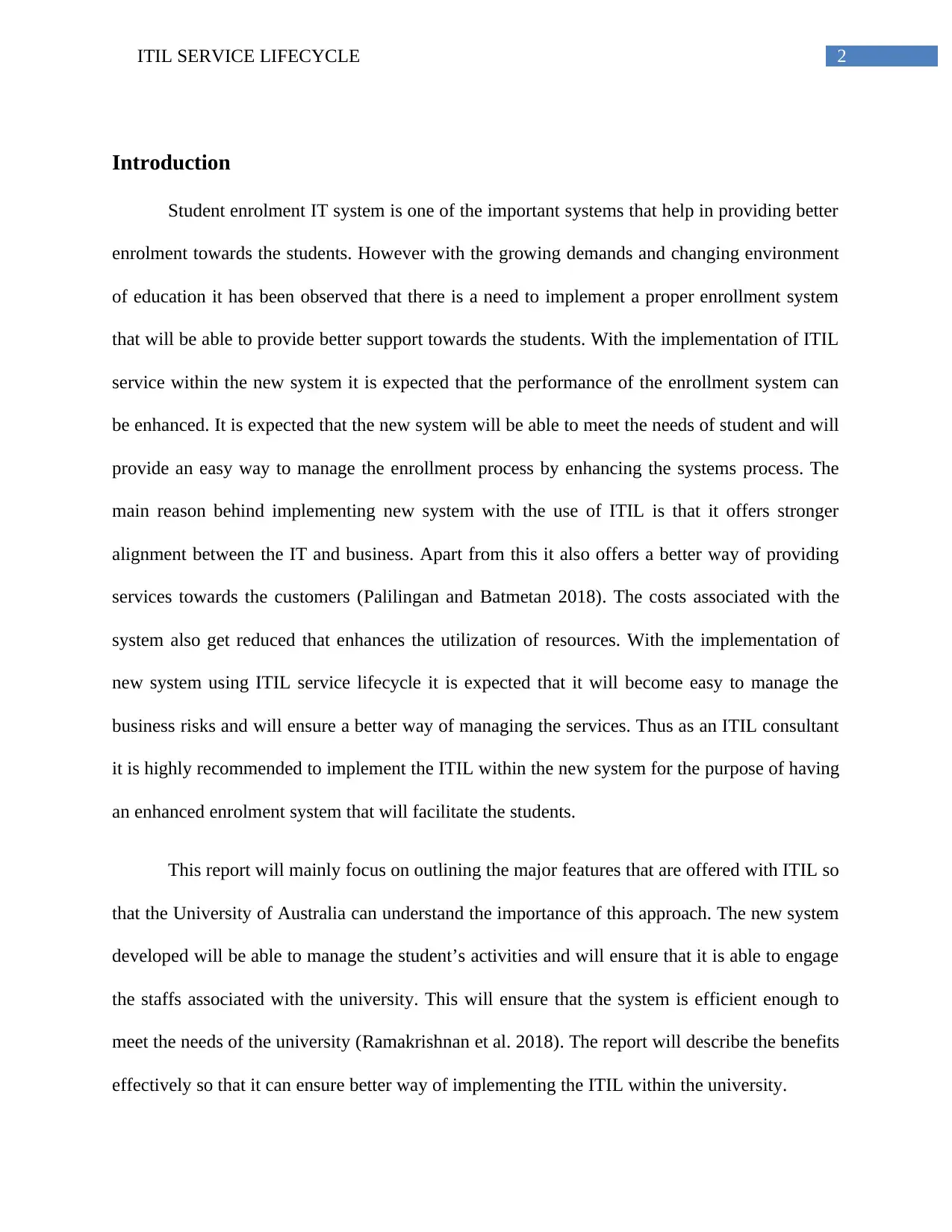
2ITIL SERVICE LIFECYCLE
Introduction
Student enrolment IT system is one of the important systems that help in providing better
enrolment towards the students. However with the growing demands and changing environment
of education it has been observed that there is a need to implement a proper enrollment system
that will be able to provide better support towards the students. With the implementation of ITIL
service within the new system it is expected that the performance of the enrollment system can
be enhanced. It is expected that the new system will be able to meet the needs of student and will
provide an easy way to manage the enrollment process by enhancing the systems process. The
main reason behind implementing new system with the use of ITIL is that it offers stronger
alignment between the IT and business. Apart from this it also offers a better way of providing
services towards the customers (Palilingan and Batmetan 2018). The costs associated with the
system also get reduced that enhances the utilization of resources. With the implementation of
new system using ITIL service lifecycle it is expected that it will become easy to manage the
business risks and will ensure a better way of managing the services. Thus as an ITIL consultant
it is highly recommended to implement the ITIL within the new system for the purpose of having
an enhanced enrolment system that will facilitate the students.
This report will mainly focus on outlining the major features that are offered with ITIL so
that the University of Australia can understand the importance of this approach. The new system
developed will be able to manage the student’s activities and will ensure that it is able to engage
the staffs associated with the university. This will ensure that the system is efficient enough to
meet the needs of the university (Ramakrishnan et al. 2018). The report will describe the benefits
effectively so that it can ensure better way of implementing the ITIL within the university.
Introduction
Student enrolment IT system is one of the important systems that help in providing better
enrolment towards the students. However with the growing demands and changing environment
of education it has been observed that there is a need to implement a proper enrollment system
that will be able to provide better support towards the students. With the implementation of ITIL
service within the new system it is expected that the performance of the enrollment system can
be enhanced. It is expected that the new system will be able to meet the needs of student and will
provide an easy way to manage the enrollment process by enhancing the systems process. The
main reason behind implementing new system with the use of ITIL is that it offers stronger
alignment between the IT and business. Apart from this it also offers a better way of providing
services towards the customers (Palilingan and Batmetan 2018). The costs associated with the
system also get reduced that enhances the utilization of resources. With the implementation of
new system using ITIL service lifecycle it is expected that it will become easy to manage the
business risks and will ensure a better way of managing the services. Thus as an ITIL consultant
it is highly recommended to implement the ITIL within the new system for the purpose of having
an enhanced enrolment system that will facilitate the students.
This report will mainly focus on outlining the major features that are offered with ITIL so
that the University of Australia can understand the importance of this approach. The new system
developed will be able to manage the student’s activities and will ensure that it is able to engage
the staffs associated with the university. This will ensure that the system is efficient enough to
meet the needs of the university (Ramakrishnan et al. 2018). The report will describe the benefits
effectively so that it can ensure better way of implementing the ITIL within the university.
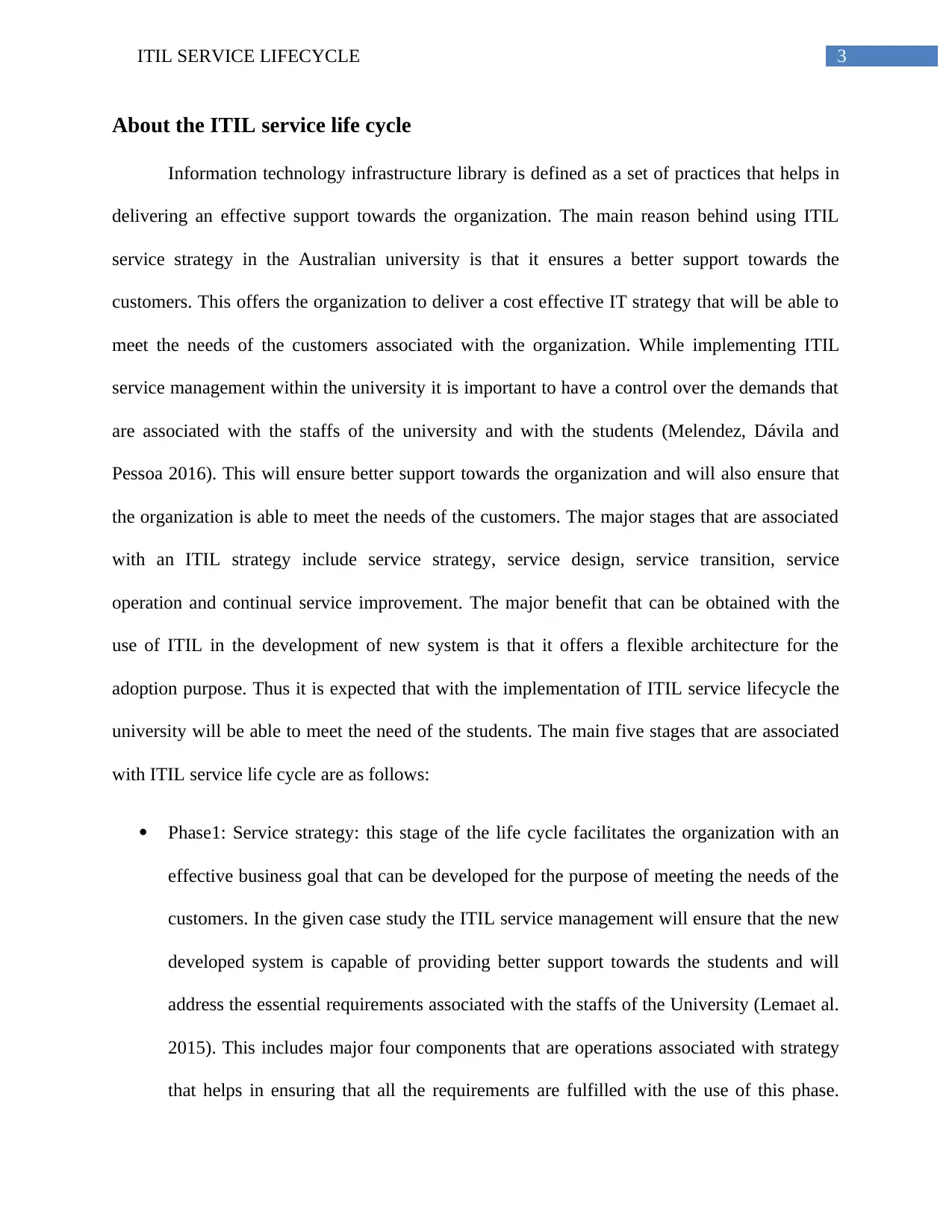
3ITIL SERVICE LIFECYCLE
About the ITIL service life cycle
Information technology infrastructure library is defined as a set of practices that helps in
delivering an effective support towards the organization. The main reason behind using ITIL
service strategy in the Australian university is that it ensures a better support towards the
customers. This offers the organization to deliver a cost effective IT strategy that will be able to
meet the needs of the customers associated with the organization. While implementing ITIL
service management within the university it is important to have a control over the demands that
are associated with the staffs of the university and with the students (Melendez, Dávila and
Pessoa 2016). This will ensure better support towards the organization and will also ensure that
the organization is able to meet the needs of the customers. The major stages that are associated
with an ITIL strategy include service strategy, service design, service transition, service
operation and continual service improvement. The major benefit that can be obtained with the
use of ITIL in the development of new system is that it offers a flexible architecture for the
adoption purpose. Thus it is expected that with the implementation of ITIL service lifecycle the
university will be able to meet the need of the students. The main five stages that are associated
with ITIL service life cycle are as follows:
Phase1: Service strategy: this stage of the life cycle facilitates the organization with an
effective business goal that can be developed for the purpose of meeting the needs of the
customers. In the given case study the ITIL service management will ensure that the new
developed system is capable of providing better support towards the students and will
address the essential requirements associated with the staffs of the University (Lemaet al.
2015). This includes major four components that are operations associated with strategy
that helps in ensuring that all the requirements are fulfilled with the use of this phase.
About the ITIL service life cycle
Information technology infrastructure library is defined as a set of practices that helps in
delivering an effective support towards the organization. The main reason behind using ITIL
service strategy in the Australian university is that it ensures a better support towards the
customers. This offers the organization to deliver a cost effective IT strategy that will be able to
meet the needs of the customers associated with the organization. While implementing ITIL
service management within the university it is important to have a control over the demands that
are associated with the staffs of the university and with the students (Melendez, Dávila and
Pessoa 2016). This will ensure better support towards the organization and will also ensure that
the organization is able to meet the needs of the customers. The major stages that are associated
with an ITIL strategy include service strategy, service design, service transition, service
operation and continual service improvement. The major benefit that can be obtained with the
use of ITIL in the development of new system is that it offers a flexible architecture for the
adoption purpose. Thus it is expected that with the implementation of ITIL service lifecycle the
university will be able to meet the need of the students. The main five stages that are associated
with ITIL service life cycle are as follows:
Phase1: Service strategy: this stage of the life cycle facilitates the organization with an
effective business goal that can be developed for the purpose of meeting the needs of the
customers. In the given case study the ITIL service management will ensure that the new
developed system is capable of providing better support towards the students and will
address the essential requirements associated with the staffs of the University (Lemaet al.
2015). This includes major four components that are operations associated with strategy
that helps in ensuring that all the requirements are fulfilled with the use of this phase.
Secure Best Marks with AI Grader
Need help grading? Try our AI Grader for instant feedback on your assignments.
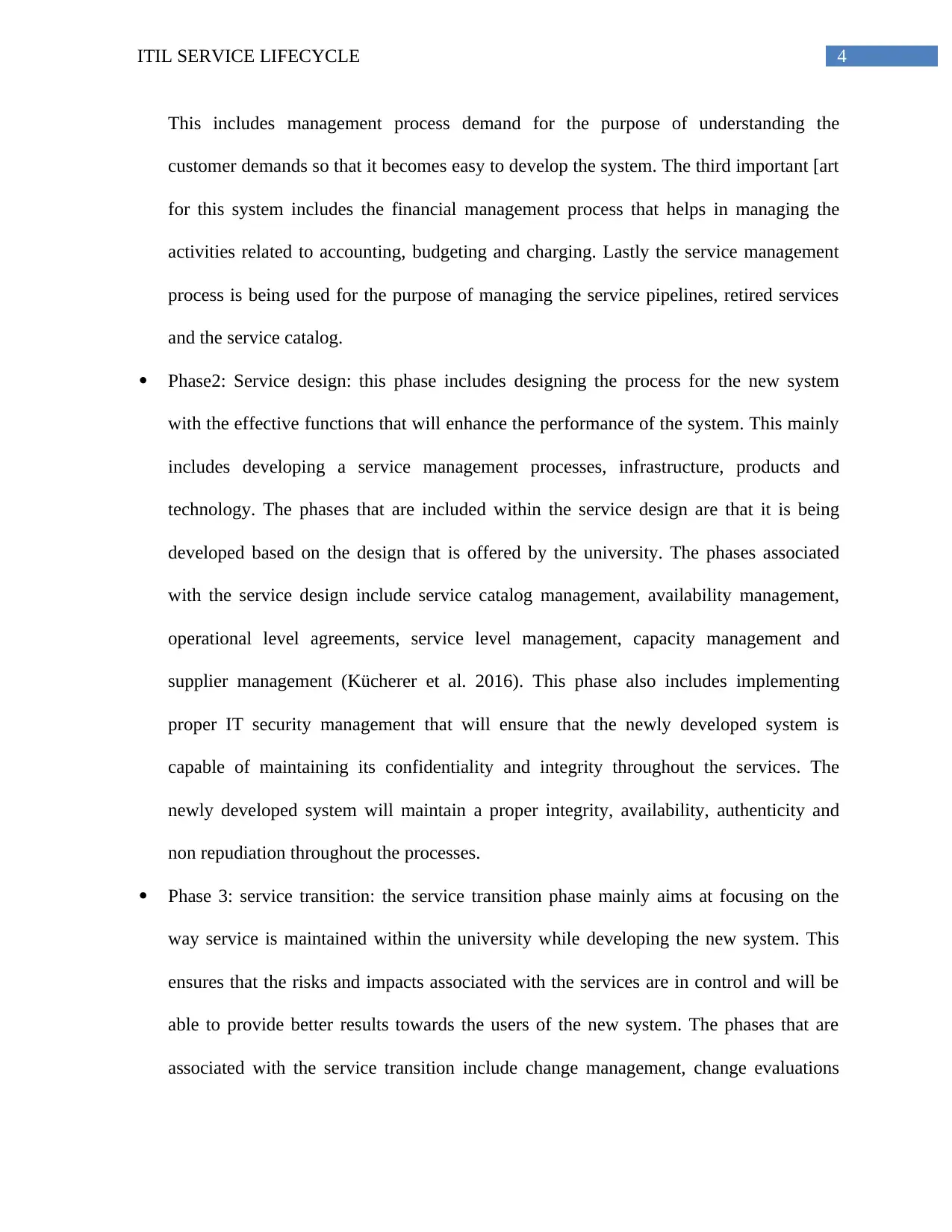
4ITIL SERVICE LIFECYCLE
This includes management process demand for the purpose of understanding the
customer demands so that it becomes easy to develop the system. The third important [art
for this system includes the financial management process that helps in managing the
activities related to accounting, budgeting and charging. Lastly the service management
process is being used for the purpose of managing the service pipelines, retired services
and the service catalog.
Phase2: Service design: this phase includes designing the process for the new system
with the effective functions that will enhance the performance of the system. This mainly
includes developing a service management processes, infrastructure, products and
technology. The phases that are included within the service design are that it is being
developed based on the design that is offered by the university. The phases associated
with the service design include service catalog management, availability management,
operational level agreements, service level management, capacity management and
supplier management (Kücherer et al. 2016). This phase also includes implementing
proper IT security management that will ensure that the newly developed system is
capable of maintaining its confidentiality and integrity throughout the services. The
newly developed system will maintain a proper integrity, availability, authenticity and
non repudiation throughout the processes.
Phase 3: service transition: the service transition phase mainly aims at focusing on the
way service is maintained within the university while developing the new system. This
ensures that the risks and impacts associated with the services are in control and will be
able to provide better results towards the users of the new system. The phases that are
associated with the service transition include change management, change evaluations
This includes management process demand for the purpose of understanding the
customer demands so that it becomes easy to develop the system. The third important [art
for this system includes the financial management process that helps in managing the
activities related to accounting, budgeting and charging. Lastly the service management
process is being used for the purpose of managing the service pipelines, retired services
and the service catalog.
Phase2: Service design: this phase includes designing the process for the new system
with the effective functions that will enhance the performance of the system. This mainly
includes developing a service management processes, infrastructure, products and
technology. The phases that are included within the service design are that it is being
developed based on the design that is offered by the university. The phases associated
with the service design include service catalog management, availability management,
operational level agreements, service level management, capacity management and
supplier management (Kücherer et al. 2016). This phase also includes implementing
proper IT security management that will ensure that the newly developed system is
capable of maintaining its confidentiality and integrity throughout the services. The
newly developed system will maintain a proper integrity, availability, authenticity and
non repudiation throughout the processes.
Phase 3: service transition: the service transition phase mainly aims at focusing on the
way service is maintained within the university while developing the new system. This
ensures that the risks and impacts associated with the services are in control and will be
able to provide better results towards the users of the new system. The phases that are
associated with the service transition include change management, change evaluations
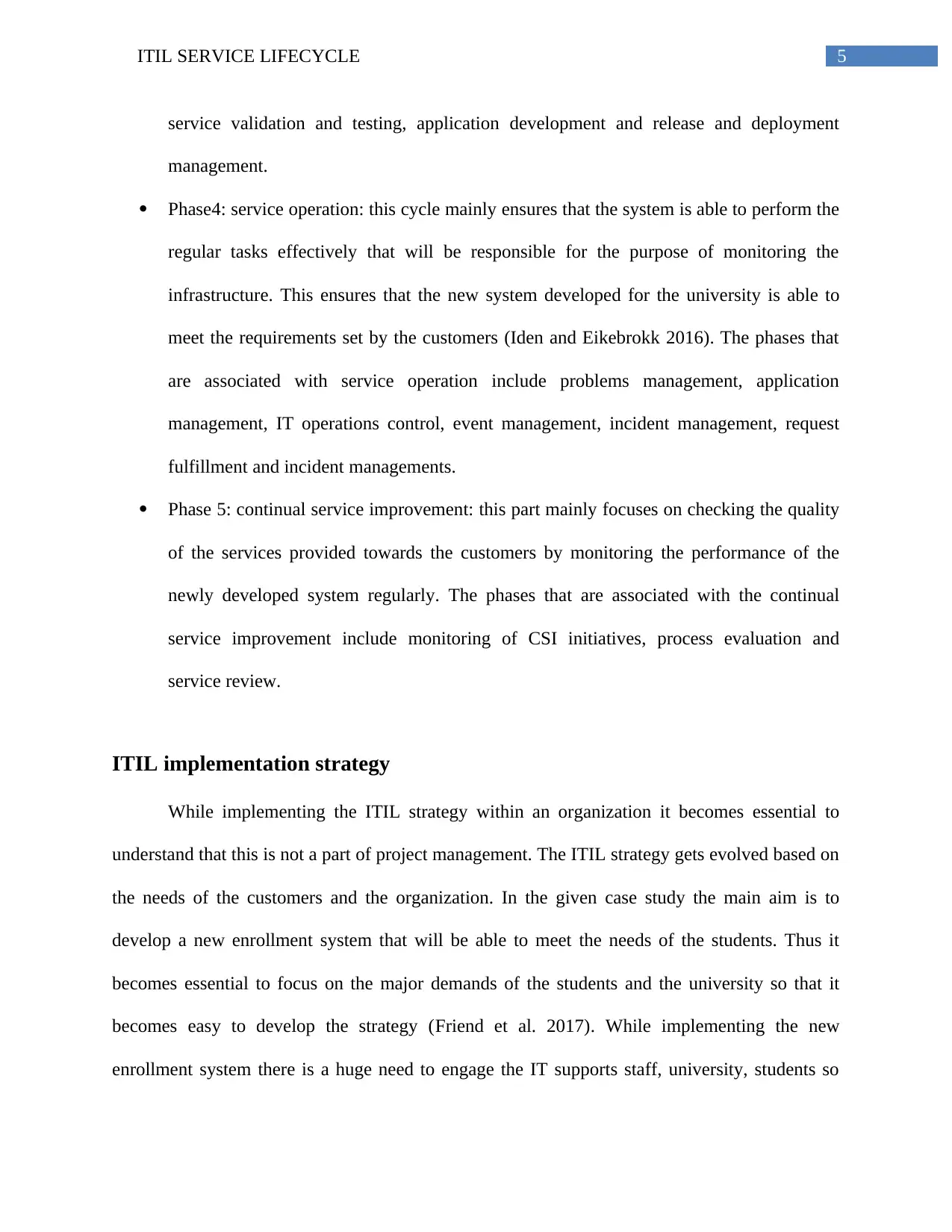
5ITIL SERVICE LIFECYCLE
service validation and testing, application development and release and deployment
management.
Phase4: service operation: this cycle mainly ensures that the system is able to perform the
regular tasks effectively that will be responsible for the purpose of monitoring the
infrastructure. This ensures that the new system developed for the university is able to
meet the requirements set by the customers (Iden and Eikebrokk 2016). The phases that
are associated with service operation include problems management, application
management, IT operations control, event management, incident management, request
fulfillment and incident managements.
Phase 5: continual service improvement: this part mainly focuses on checking the quality
of the services provided towards the customers by monitoring the performance of the
newly developed system regularly. The phases that are associated with the continual
service improvement include monitoring of CSI initiatives, process evaluation and
service review.
ITIL implementation strategy
While implementing the ITIL strategy within an organization it becomes essential to
understand that this is not a part of project management. The ITIL strategy gets evolved based on
the needs of the customers and the organization. In the given case study the main aim is to
develop a new enrollment system that will be able to meet the needs of the students. Thus it
becomes essential to focus on the major demands of the students and the university so that it
becomes easy to develop the strategy (Friend et al. 2017). While implementing the new
enrollment system there is a huge need to engage the IT supports staff, university, students so
service validation and testing, application development and release and deployment
management.
Phase4: service operation: this cycle mainly ensures that the system is able to perform the
regular tasks effectively that will be responsible for the purpose of monitoring the
infrastructure. This ensures that the new system developed for the university is able to
meet the requirements set by the customers (Iden and Eikebrokk 2016). The phases that
are associated with service operation include problems management, application
management, IT operations control, event management, incident management, request
fulfillment and incident managements.
Phase 5: continual service improvement: this part mainly focuses on checking the quality
of the services provided towards the customers by monitoring the performance of the
newly developed system regularly. The phases that are associated with the continual
service improvement include monitoring of CSI initiatives, process evaluation and
service review.
ITIL implementation strategy
While implementing the ITIL strategy within an organization it becomes essential to
understand that this is not a part of project management. The ITIL strategy gets evolved based on
the needs of the customers and the organization. In the given case study the main aim is to
develop a new enrollment system that will be able to meet the needs of the students. Thus it
becomes essential to focus on the major demands of the students and the university so that it
becomes easy to develop the strategy (Friend et al. 2017). While implementing the new
enrollment system there is a huge need to engage the IT supports staff, university, students so
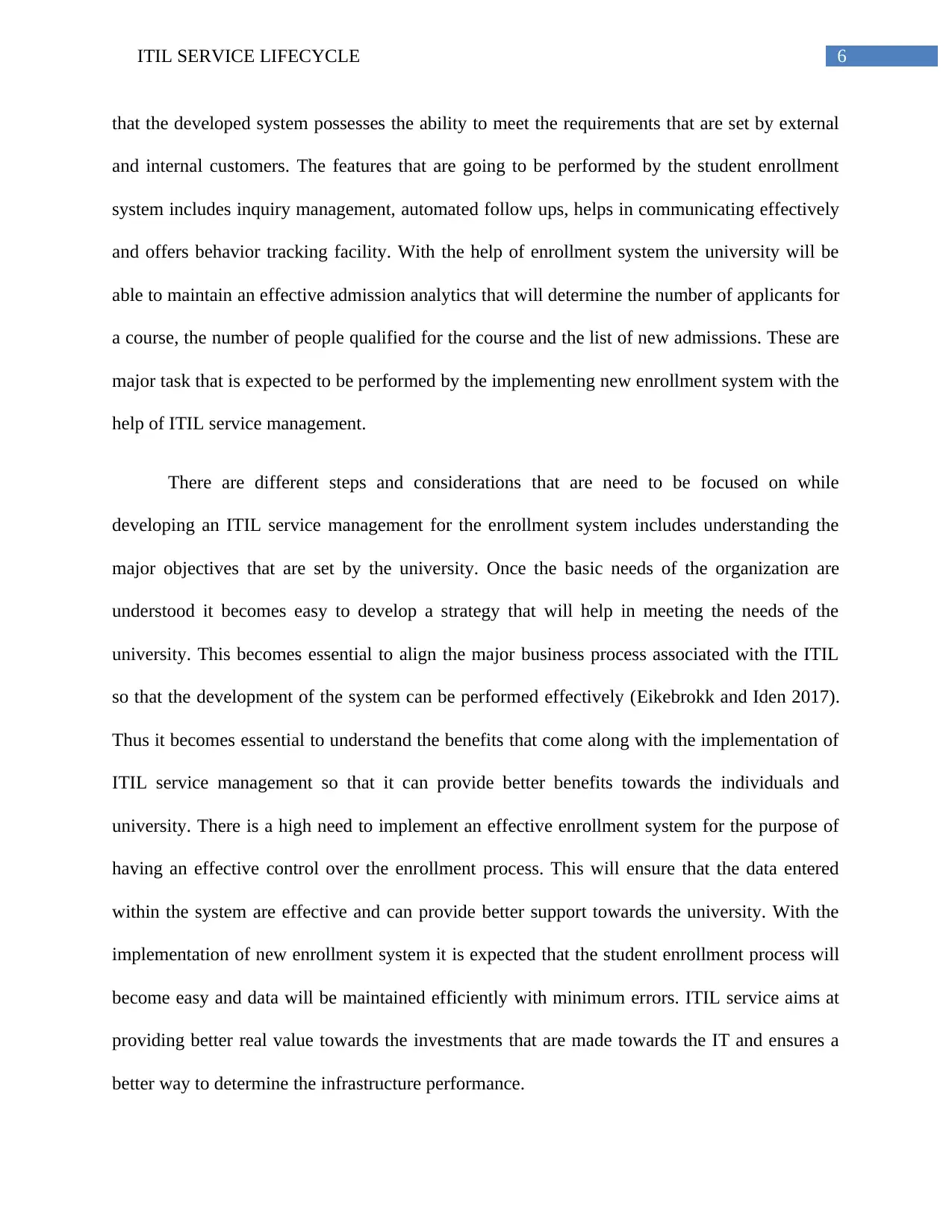
6ITIL SERVICE LIFECYCLE
that the developed system possesses the ability to meet the requirements that are set by external
and internal customers. The features that are going to be performed by the student enrollment
system includes inquiry management, automated follow ups, helps in communicating effectively
and offers behavior tracking facility. With the help of enrollment system the university will be
able to maintain an effective admission analytics that will determine the number of applicants for
a course, the number of people qualified for the course and the list of new admissions. These are
major task that is expected to be performed by the implementing new enrollment system with the
help of ITIL service management.
There are different steps and considerations that are need to be focused on while
developing an ITIL service management for the enrollment system includes understanding the
major objectives that are set by the university. Once the basic needs of the organization are
understood it becomes easy to develop a strategy that will help in meeting the needs of the
university. This becomes essential to align the major business process associated with the ITIL
so that the development of the system can be performed effectively (Eikebrokk and Iden 2017).
Thus it becomes essential to understand the benefits that come along with the implementation of
ITIL service management so that it can provide better benefits towards the individuals and
university. There is a high need to implement an effective enrollment system for the purpose of
having an effective control over the enrollment process. This will ensure that the data entered
within the system are effective and can provide better support towards the university. With the
implementation of new enrollment system it is expected that the student enrollment process will
become easy and data will be maintained efficiently with minimum errors. ITIL service aims at
providing better real value towards the investments that are made towards the IT and ensures a
better way to determine the infrastructure performance.
that the developed system possesses the ability to meet the requirements that are set by external
and internal customers. The features that are going to be performed by the student enrollment
system includes inquiry management, automated follow ups, helps in communicating effectively
and offers behavior tracking facility. With the help of enrollment system the university will be
able to maintain an effective admission analytics that will determine the number of applicants for
a course, the number of people qualified for the course and the list of new admissions. These are
major task that is expected to be performed by the implementing new enrollment system with the
help of ITIL service management.
There are different steps and considerations that are need to be focused on while
developing an ITIL service management for the enrollment system includes understanding the
major objectives that are set by the university. Once the basic needs of the organization are
understood it becomes easy to develop a strategy that will help in meeting the needs of the
university. This becomes essential to align the major business process associated with the ITIL
so that the development of the system can be performed effectively (Eikebrokk and Iden 2017).
Thus it becomes essential to understand the benefits that come along with the implementation of
ITIL service management so that it can provide better benefits towards the individuals and
university. There is a high need to implement an effective enrollment system for the purpose of
having an effective control over the enrollment process. This will ensure that the data entered
within the system are effective and can provide better support towards the university. With the
implementation of new enrollment system it is expected that the student enrollment process will
become easy and data will be maintained efficiently with minimum errors. ITIL service aims at
providing better real value towards the investments that are made towards the IT and ensures a
better way to determine the infrastructure performance.
Paraphrase This Document
Need a fresh take? Get an instant paraphrase of this document with our AI Paraphraser
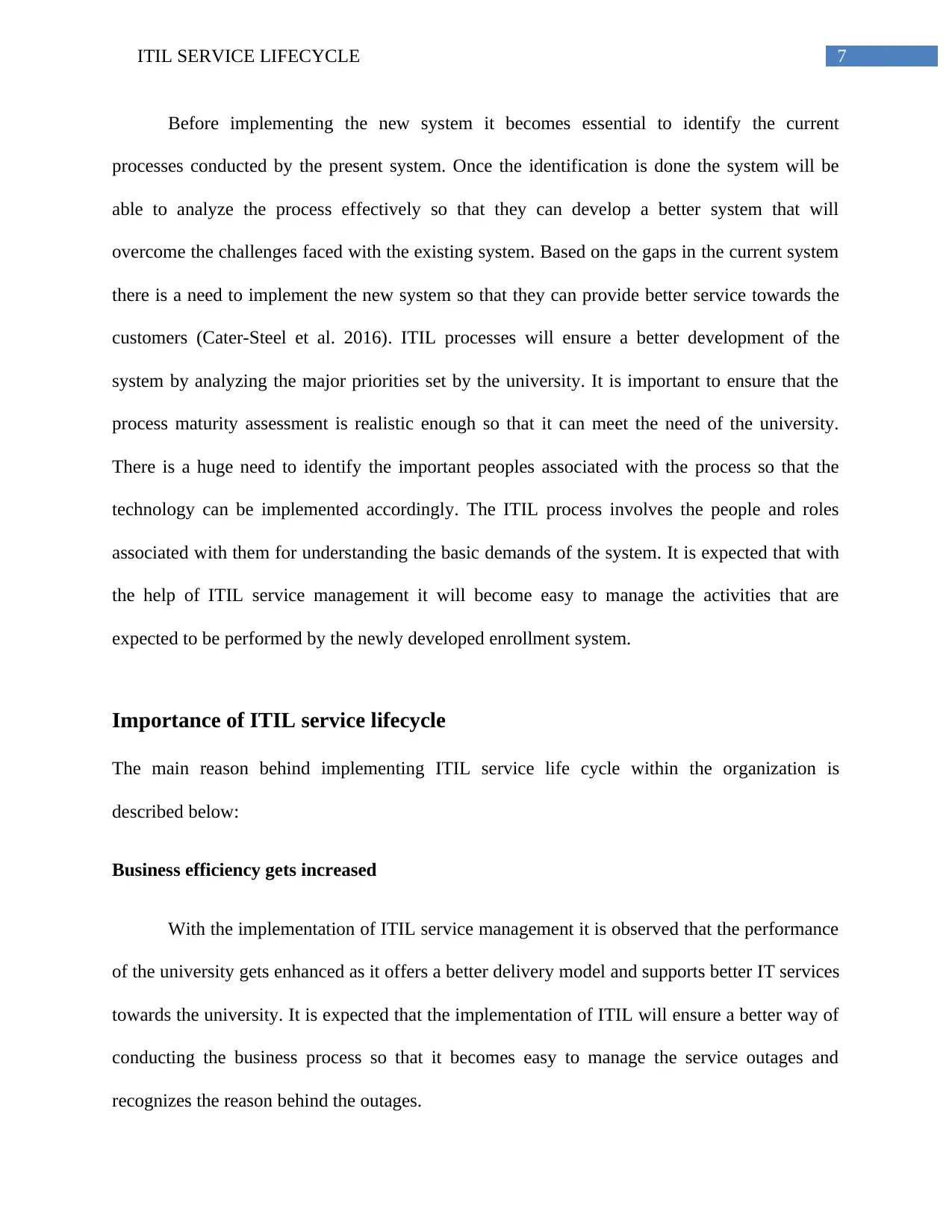
7ITIL SERVICE LIFECYCLE
Before implementing the new system it becomes essential to identify the current
processes conducted by the present system. Once the identification is done the system will be
able to analyze the process effectively so that they can develop a better system that will
overcome the challenges faced with the existing system. Based on the gaps in the current system
there is a need to implement the new system so that they can provide better service towards the
customers (Cater-Steel et al. 2016). ITIL processes will ensure a better development of the
system by analyzing the major priorities set by the university. It is important to ensure that the
process maturity assessment is realistic enough so that it can meet the need of the university.
There is a huge need to identify the important peoples associated with the process so that the
technology can be implemented accordingly. The ITIL process involves the people and roles
associated with them for understanding the basic demands of the system. It is expected that with
the help of ITIL service management it will become easy to manage the activities that are
expected to be performed by the newly developed enrollment system.
Importance of ITIL service lifecycle
The main reason behind implementing ITIL service life cycle within the organization is
described below:
Business efficiency gets increased
With the implementation of ITIL service management it is observed that the performance
of the university gets enhanced as it offers a better delivery model and supports better IT services
towards the university. It is expected that the implementation of ITIL will ensure a better way of
conducting the business process so that it becomes easy to manage the service outages and
recognizes the reason behind the outages.
Before implementing the new system it becomes essential to identify the current
processes conducted by the present system. Once the identification is done the system will be
able to analyze the process effectively so that they can develop a better system that will
overcome the challenges faced with the existing system. Based on the gaps in the current system
there is a need to implement the new system so that they can provide better service towards the
customers (Cater-Steel et al. 2016). ITIL processes will ensure a better development of the
system by analyzing the major priorities set by the university. It is important to ensure that the
process maturity assessment is realistic enough so that it can meet the need of the university.
There is a huge need to identify the important peoples associated with the process so that the
technology can be implemented accordingly. The ITIL process involves the people and roles
associated with them for understanding the basic demands of the system. It is expected that with
the help of ITIL service management it will become easy to manage the activities that are
expected to be performed by the newly developed enrollment system.
Importance of ITIL service lifecycle
The main reason behind implementing ITIL service life cycle within the organization is
described below:
Business efficiency gets increased
With the implementation of ITIL service management it is observed that the performance
of the university gets enhanced as it offers a better delivery model and supports better IT services
towards the university. It is expected that the implementation of ITIL will ensure a better way of
conducting the business process so that it becomes easy to manage the service outages and
recognizes the reason behind the outages.
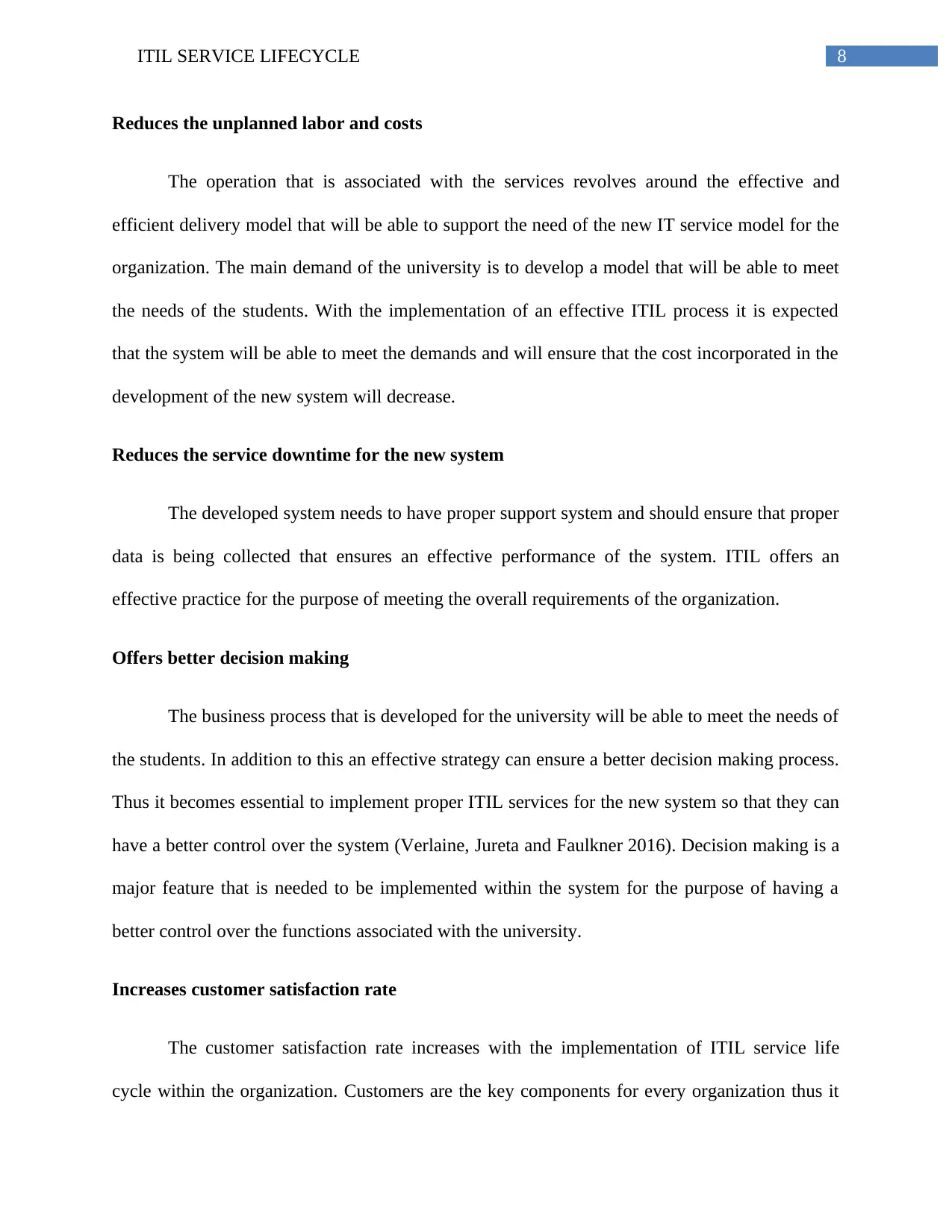
8ITIL SERVICE LIFECYCLE
Reduces the unplanned labor and costs
The operation that is associated with the services revolves around the effective and
efficient delivery model that will be able to support the need of the new IT service model for the
organization. The main demand of the university is to develop a model that will be able to meet
the needs of the students. With the implementation of an effective ITIL process it is expected
that the system will be able to meet the demands and will ensure that the cost incorporated in the
development of the new system will decrease.
Reduces the service downtime for the new system
The developed system needs to have proper support system and should ensure that proper
data is being collected that ensures an effective performance of the system. ITIL offers an
effective practice for the purpose of meeting the overall requirements of the organization.
Offers better decision making
The business process that is developed for the university will be able to meet the needs of
the students. In addition to this an effective strategy can ensure a better decision making process.
Thus it becomes essential to implement proper ITIL services for the new system so that they can
have a better control over the system (Verlaine, Jureta and Faulkner 2016). Decision making is a
major feature that is needed to be implemented within the system for the purpose of having a
better control over the functions associated with the university.
Increases customer satisfaction rate
The customer satisfaction rate increases with the implementation of ITIL service life
cycle within the organization. Customers are the key components for every organization thus it
Reduces the unplanned labor and costs
The operation that is associated with the services revolves around the effective and
efficient delivery model that will be able to support the need of the new IT service model for the
organization. The main demand of the university is to develop a model that will be able to meet
the needs of the students. With the implementation of an effective ITIL process it is expected
that the system will be able to meet the demands and will ensure that the cost incorporated in the
development of the new system will decrease.
Reduces the service downtime for the new system
The developed system needs to have proper support system and should ensure that proper
data is being collected that ensures an effective performance of the system. ITIL offers an
effective practice for the purpose of meeting the overall requirements of the organization.
Offers better decision making
The business process that is developed for the university will be able to meet the needs of
the students. In addition to this an effective strategy can ensure a better decision making process.
Thus it becomes essential to implement proper ITIL services for the new system so that they can
have a better control over the system (Verlaine, Jureta and Faulkner 2016). Decision making is a
major feature that is needed to be implemented within the system for the purpose of having a
better control over the functions associated with the university.
Increases customer satisfaction rate
The customer satisfaction rate increases with the implementation of ITIL service life
cycle within the organization. Customers are the key components for every organization thus it
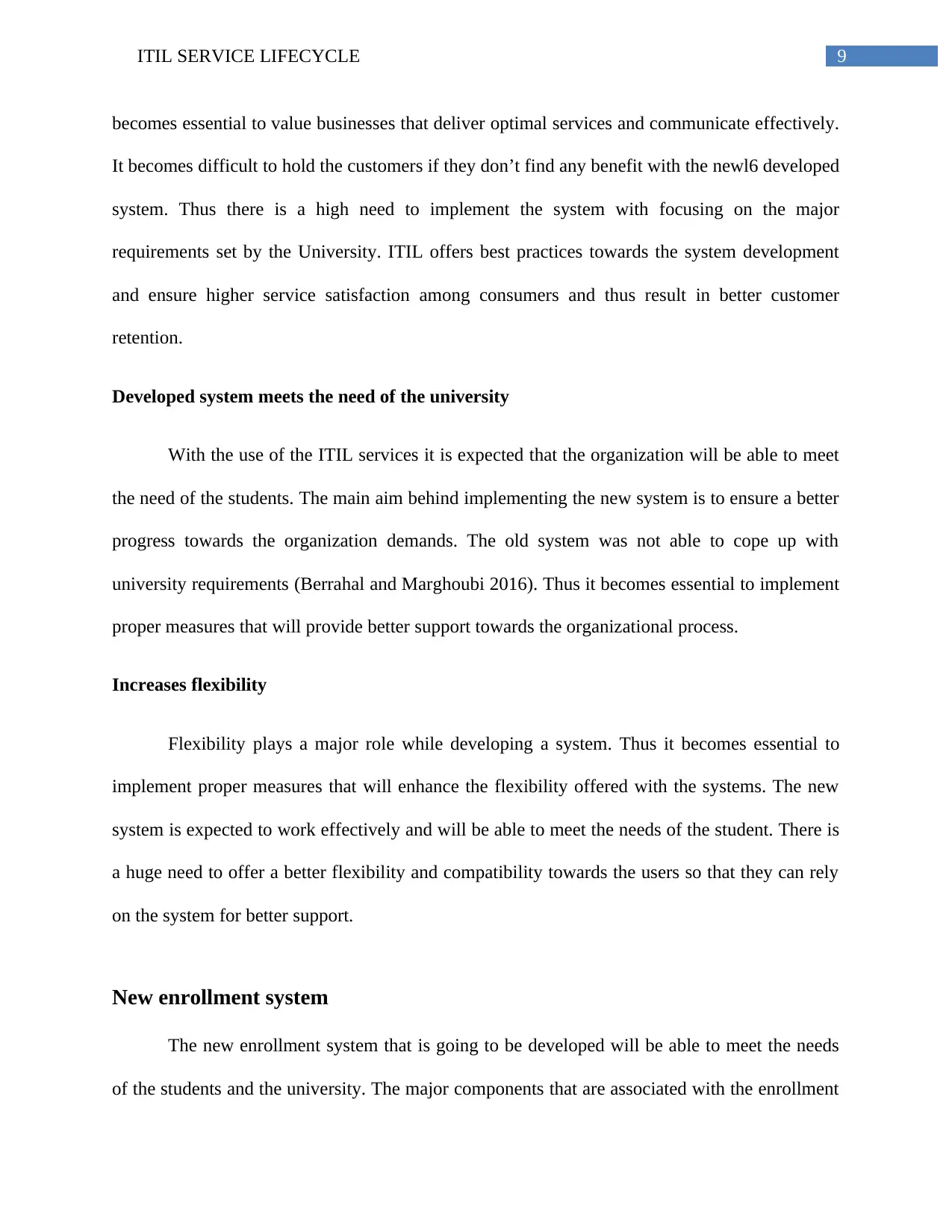
9ITIL SERVICE LIFECYCLE
becomes essential to value businesses that deliver optimal services and communicate effectively.
It becomes difficult to hold the customers if they don’t find any benefit with the newl6 developed
system. Thus there is a high need to implement the system with focusing on the major
requirements set by the University. ITIL offers best practices towards the system development
and ensure higher service satisfaction among consumers and thus result in better customer
retention.
Developed system meets the need of the university
With the use of the ITIL services it is expected that the organization will be able to meet
the need of the students. The main aim behind implementing the new system is to ensure a better
progress towards the organization demands. The old system was not able to cope up with
university requirements (Berrahal and Marghoubi 2016). Thus it becomes essential to implement
proper measures that will provide better support towards the organizational process.
Increases flexibility
Flexibility plays a major role while developing a system. Thus it becomes essential to
implement proper measures that will enhance the flexibility offered with the systems. The new
system is expected to work effectively and will be able to meet the needs of the student. There is
a huge need to offer a better flexibility and compatibility towards the users so that they can rely
on the system for better support.
New enrollment system
The new enrollment system that is going to be developed will be able to meet the needs
of the students and the university. The major components that are associated with the enrollment
becomes essential to value businesses that deliver optimal services and communicate effectively.
It becomes difficult to hold the customers if they don’t find any benefit with the newl6 developed
system. Thus there is a high need to implement the system with focusing on the major
requirements set by the University. ITIL offers best practices towards the system development
and ensure higher service satisfaction among consumers and thus result in better customer
retention.
Developed system meets the need of the university
With the use of the ITIL services it is expected that the organization will be able to meet
the need of the students. The main aim behind implementing the new system is to ensure a better
progress towards the organization demands. The old system was not able to cope up with
university requirements (Berrahal and Marghoubi 2016). Thus it becomes essential to implement
proper measures that will provide better support towards the organizational process.
Increases flexibility
Flexibility plays a major role while developing a system. Thus it becomes essential to
implement proper measures that will enhance the flexibility offered with the systems. The new
system is expected to work effectively and will be able to meet the needs of the student. There is
a huge need to offer a better flexibility and compatibility towards the users so that they can rely
on the system for better support.
New enrollment system
The new enrollment system that is going to be developed will be able to meet the needs
of the students and the university. The major components that are associated with the enrollment
Secure Best Marks with AI Grader
Need help grading? Try our AI Grader for instant feedback on your assignments.
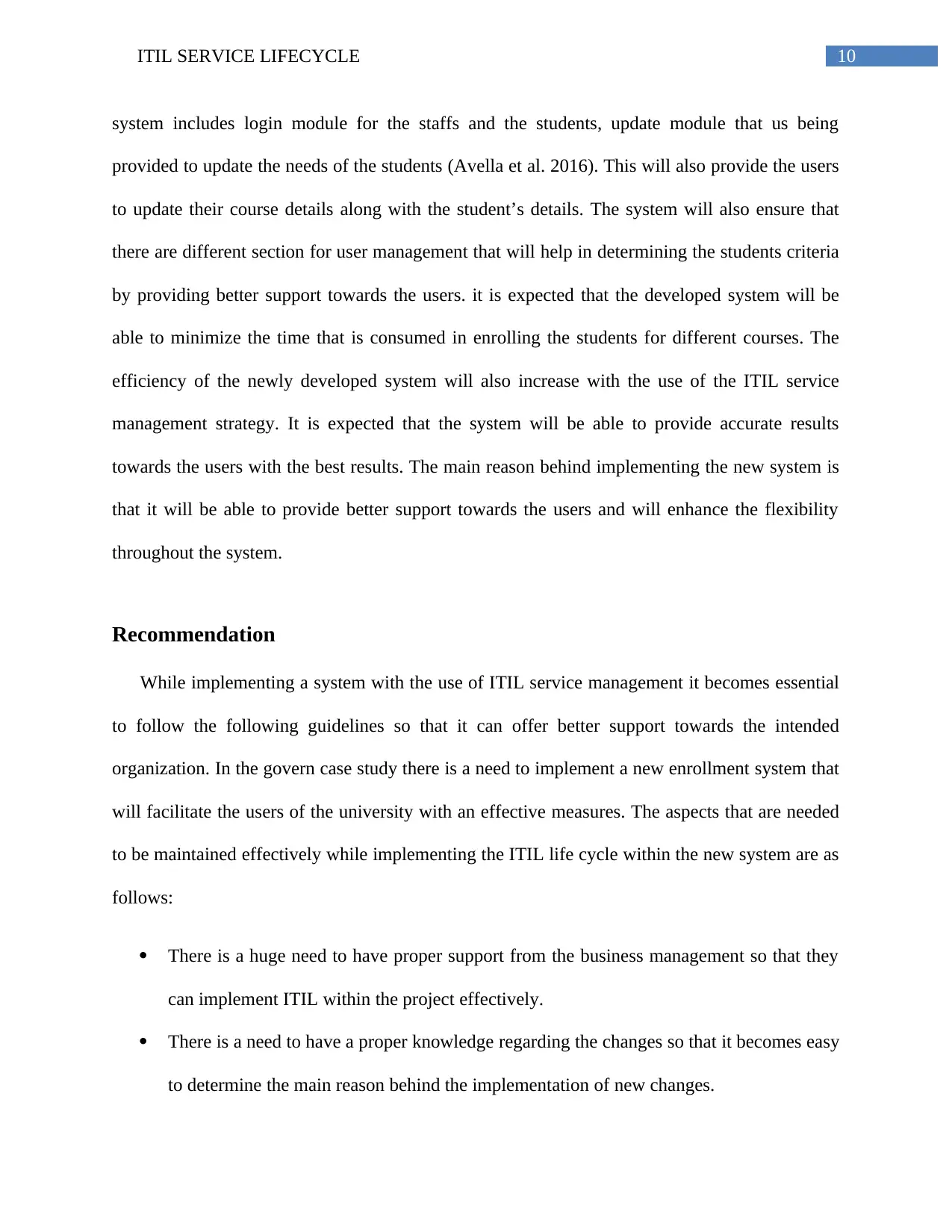
10ITIL SERVICE LIFECYCLE
system includes login module for the staffs and the students, update module that us being
provided to update the needs of the students (Avella et al. 2016). This will also provide the users
to update their course details along with the student’s details. The system will also ensure that
there are different section for user management that will help in determining the students criteria
by providing better support towards the users. it is expected that the developed system will be
able to minimize the time that is consumed in enrolling the students for different courses. The
efficiency of the newly developed system will also increase with the use of the ITIL service
management strategy. It is expected that the system will be able to provide accurate results
towards the users with the best results. The main reason behind implementing the new system is
that it will be able to provide better support towards the users and will enhance the flexibility
throughout the system.
Recommendation
While implementing a system with the use of ITIL service management it becomes essential
to follow the following guidelines so that it can offer better support towards the intended
organization. In the govern case study there is a need to implement a new enrollment system that
will facilitate the users of the university with an effective measures. The aspects that are needed
to be maintained effectively while implementing the ITIL life cycle within the new system are as
follows:
There is a huge need to have proper support from the business management so that they
can implement ITIL within the project effectively.
There is a need to have a proper knowledge regarding the changes so that it becomes easy
to determine the main reason behind the implementation of new changes.
system includes login module for the staffs and the students, update module that us being
provided to update the needs of the students (Avella et al. 2016). This will also provide the users
to update their course details along with the student’s details. The system will also ensure that
there are different section for user management that will help in determining the students criteria
by providing better support towards the users. it is expected that the developed system will be
able to minimize the time that is consumed in enrolling the students for different courses. The
efficiency of the newly developed system will also increase with the use of the ITIL service
management strategy. It is expected that the system will be able to provide accurate results
towards the users with the best results. The main reason behind implementing the new system is
that it will be able to provide better support towards the users and will enhance the flexibility
throughout the system.
Recommendation
While implementing a system with the use of ITIL service management it becomes essential
to follow the following guidelines so that it can offer better support towards the intended
organization. In the govern case study there is a need to implement a new enrollment system that
will facilitate the users of the university with an effective measures. The aspects that are needed
to be maintained effectively while implementing the ITIL life cycle within the new system are as
follows:
There is a huge need to have proper support from the business management so that they
can implement ITIL within the project effectively.
There is a need to have a proper knowledge regarding the changes so that it becomes easy
to determine the main reason behind the implementation of new changes.
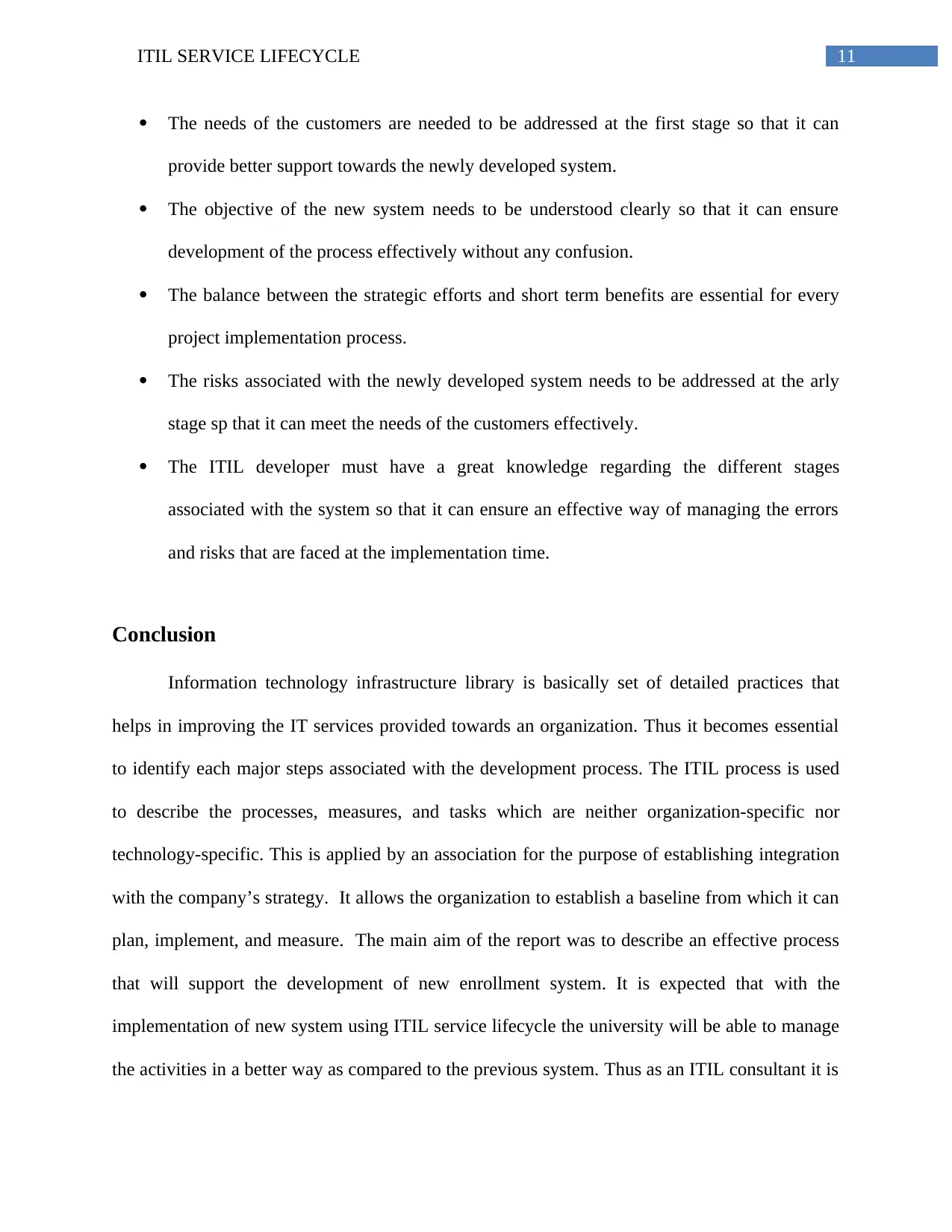
11ITIL SERVICE LIFECYCLE
The needs of the customers are needed to be addressed at the first stage so that it can
provide better support towards the newly developed system.
The objective of the new system needs to be understood clearly so that it can ensure
development of the process effectively without any confusion.
The balance between the strategic efforts and short term benefits are essential for every
project implementation process.
The risks associated with the newly developed system needs to be addressed at the arly
stage sp that it can meet the needs of the customers effectively.
The ITIL developer must have a great knowledge regarding the different stages
associated with the system so that it can ensure an effective way of managing the errors
and risks that are faced at the implementation time.
Conclusion
Information technology infrastructure library is basically set of detailed practices that
helps in improving the IT services provided towards an organization. Thus it becomes essential
to identify each major steps associated with the development process. The ITIL process is used
to describe the processes, measures, and tasks which are neither organization-specific nor
technology-specific. This is applied by an association for the purpose of establishing integration
with the company’s strategy. It allows the organization to establish a baseline from which it can
plan, implement, and measure. The main aim of the report was to describe an effective process
that will support the development of new enrollment system. It is expected that with the
implementation of new system using ITIL service lifecycle the university will be able to manage
the activities in a better way as compared to the previous system. Thus as an ITIL consultant it is
The needs of the customers are needed to be addressed at the first stage so that it can
provide better support towards the newly developed system.
The objective of the new system needs to be understood clearly so that it can ensure
development of the process effectively without any confusion.
The balance between the strategic efforts and short term benefits are essential for every
project implementation process.
The risks associated with the newly developed system needs to be addressed at the arly
stage sp that it can meet the needs of the customers effectively.
The ITIL developer must have a great knowledge regarding the different stages
associated with the system so that it can ensure an effective way of managing the errors
and risks that are faced at the implementation time.
Conclusion
Information technology infrastructure library is basically set of detailed practices that
helps in improving the IT services provided towards an organization. Thus it becomes essential
to identify each major steps associated with the development process. The ITIL process is used
to describe the processes, measures, and tasks which are neither organization-specific nor
technology-specific. This is applied by an association for the purpose of establishing integration
with the company’s strategy. It allows the organization to establish a baseline from which it can
plan, implement, and measure. The main aim of the report was to describe an effective process
that will support the development of new enrollment system. It is expected that with the
implementation of new system using ITIL service lifecycle the university will be able to manage
the activities in a better way as compared to the previous system. Thus as an ITIL consultant it is
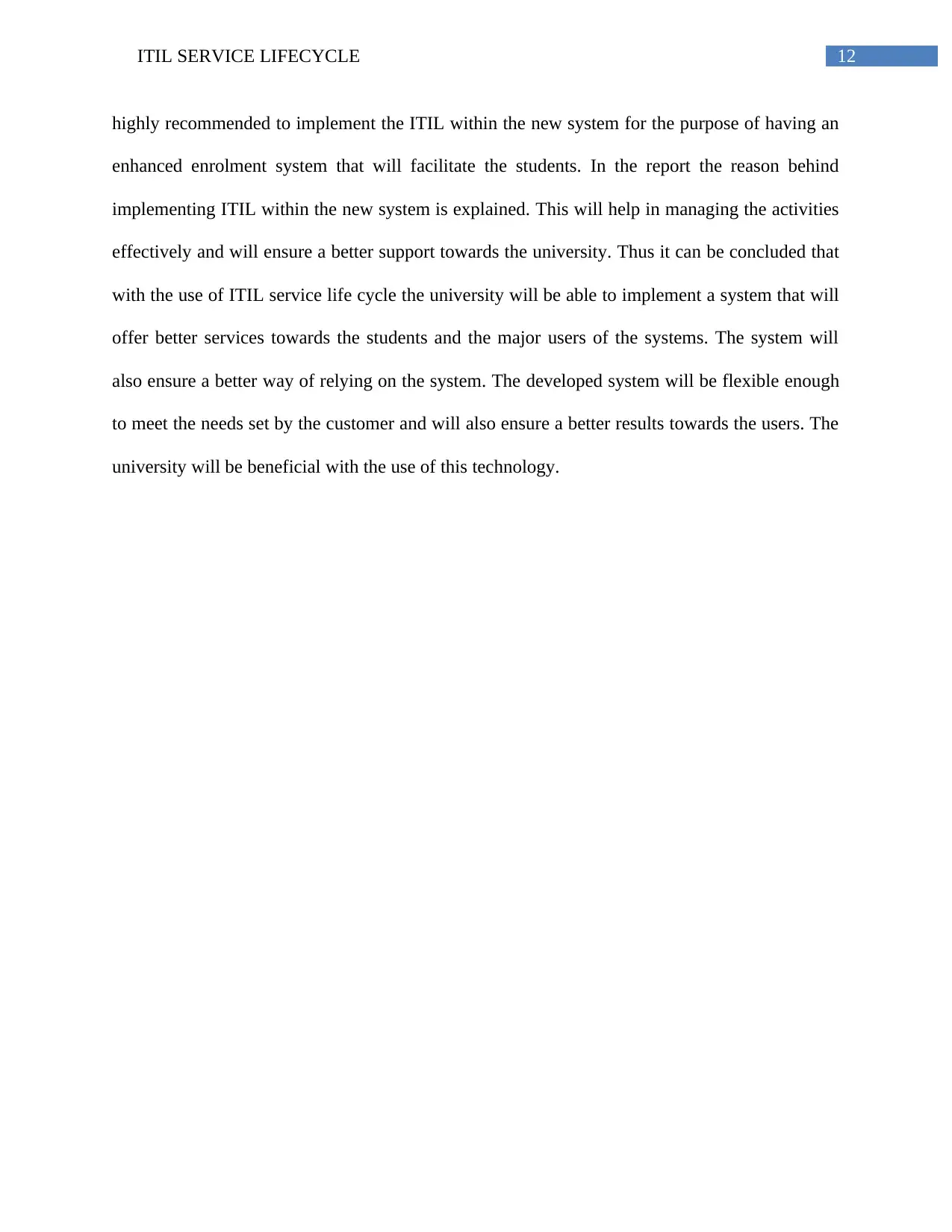
12ITIL SERVICE LIFECYCLE
highly recommended to implement the ITIL within the new system for the purpose of having an
enhanced enrolment system that will facilitate the students. In the report the reason behind
implementing ITIL within the new system is explained. This will help in managing the activities
effectively and will ensure a better support towards the university. Thus it can be concluded that
with the use of ITIL service life cycle the university will be able to implement a system that will
offer better services towards the students and the major users of the systems. The system will
also ensure a better way of relying on the system. The developed system will be flexible enough
to meet the needs set by the customer and will also ensure a better results towards the users. The
university will be beneficial with the use of this technology.
highly recommended to implement the ITIL within the new system for the purpose of having an
enhanced enrolment system that will facilitate the students. In the report the reason behind
implementing ITIL within the new system is explained. This will help in managing the activities
effectively and will ensure a better support towards the university. Thus it can be concluded that
with the use of ITIL service life cycle the university will be able to implement a system that will
offer better services towards the students and the major users of the systems. The system will
also ensure a better way of relying on the system. The developed system will be flexible enough
to meet the needs set by the customer and will also ensure a better results towards the users. The
university will be beneficial with the use of this technology.
Paraphrase This Document
Need a fresh take? Get an instant paraphrase of this document with our AI Paraphraser
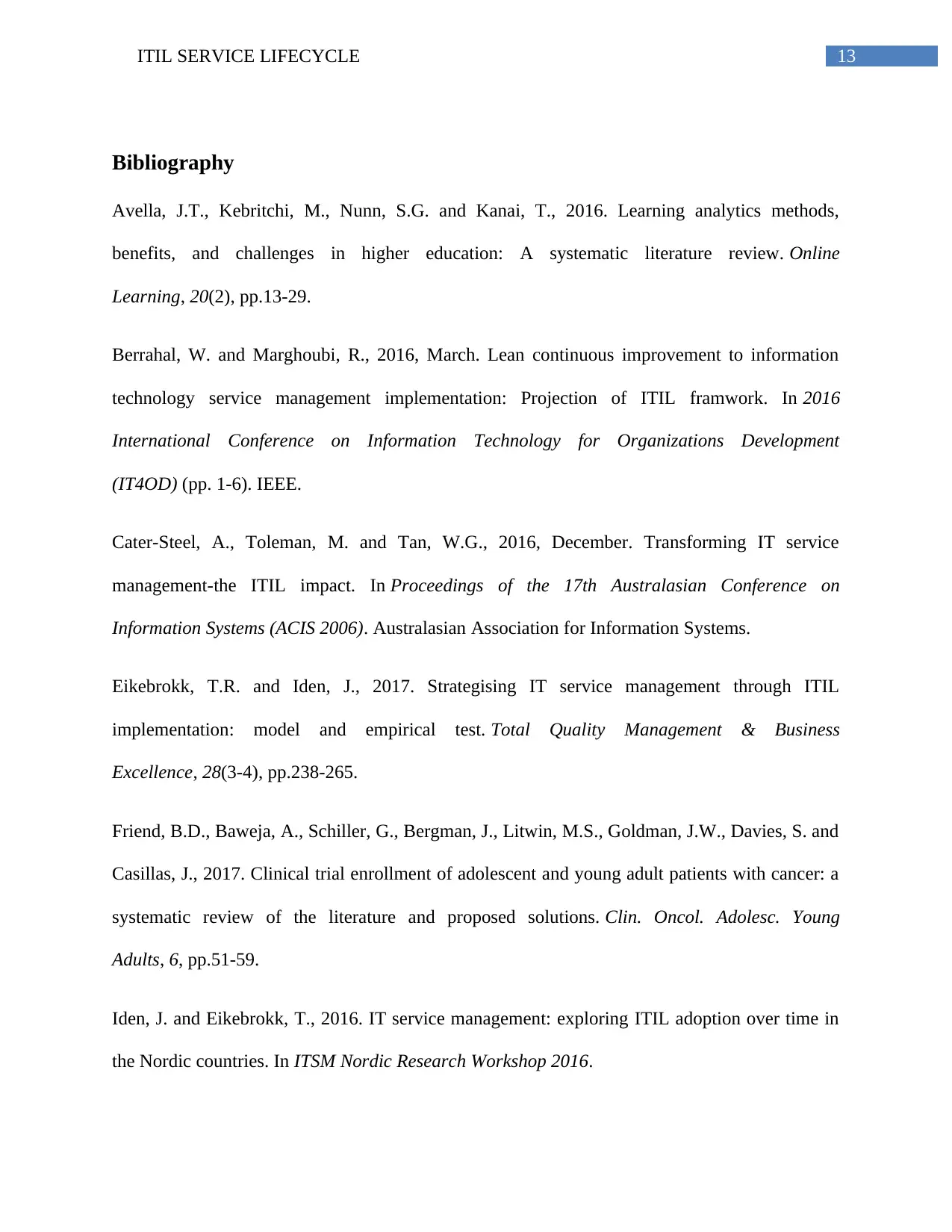
13ITIL SERVICE LIFECYCLE
Bibliography
Avella, J.T., Kebritchi, M., Nunn, S.G. and Kanai, T., 2016. Learning analytics methods,
benefits, and challenges in higher education: A systematic literature review. Online
Learning, 20(2), pp.13-29.
Berrahal, W. and Marghoubi, R., 2016, March. Lean continuous improvement to information
technology service management implementation: Projection of ITIL framwork. In 2016
International Conference on Information Technology for Organizations Development
(IT4OD) (pp. 1-6). IEEE.
Cater-Steel, A., Toleman, M. and Tan, W.G., 2016, December. Transforming IT service
management-the ITIL impact. In Proceedings of the 17th Australasian Conference on
Information Systems (ACIS 2006). Australasian Association for Information Systems.
Eikebrokk, T.R. and Iden, J., 2017. Strategising IT service management through ITIL
implementation: model and empirical test. Total Quality Management & Business
Excellence, 28(3-4), pp.238-265.
Friend, B.D., Baweja, A., Schiller, G., Bergman, J., Litwin, M.S., Goldman, J.W., Davies, S. and
Casillas, J., 2017. Clinical trial enrollment of adolescent and young adult patients with cancer: a
systematic review of the literature and proposed solutions. Clin. Oncol. Adolesc. Young
Adults, 6, pp.51-59.
Iden, J. and Eikebrokk, T., 2016. IT service management: exploring ITIL adoption over time in
the Nordic countries. In ITSM Nordic Research Workshop 2016.
Bibliography
Avella, J.T., Kebritchi, M., Nunn, S.G. and Kanai, T., 2016. Learning analytics methods,
benefits, and challenges in higher education: A systematic literature review. Online
Learning, 20(2), pp.13-29.
Berrahal, W. and Marghoubi, R., 2016, March. Lean continuous improvement to information
technology service management implementation: Projection of ITIL framwork. In 2016
International Conference on Information Technology for Organizations Development
(IT4OD) (pp. 1-6). IEEE.
Cater-Steel, A., Toleman, M. and Tan, W.G., 2016, December. Transforming IT service
management-the ITIL impact. In Proceedings of the 17th Australasian Conference on
Information Systems (ACIS 2006). Australasian Association for Information Systems.
Eikebrokk, T.R. and Iden, J., 2017. Strategising IT service management through ITIL
implementation: model and empirical test. Total Quality Management & Business
Excellence, 28(3-4), pp.238-265.
Friend, B.D., Baweja, A., Schiller, G., Bergman, J., Litwin, M.S., Goldman, J.W., Davies, S. and
Casillas, J., 2017. Clinical trial enrollment of adolescent and young adult patients with cancer: a
systematic review of the literature and proposed solutions. Clin. Oncol. Adolesc. Young
Adults, 6, pp.51-59.
Iden, J. and Eikebrokk, T., 2016. IT service management: exploring ITIL adoption over time in
the Nordic countries. In ITSM Nordic Research Workshop 2016.
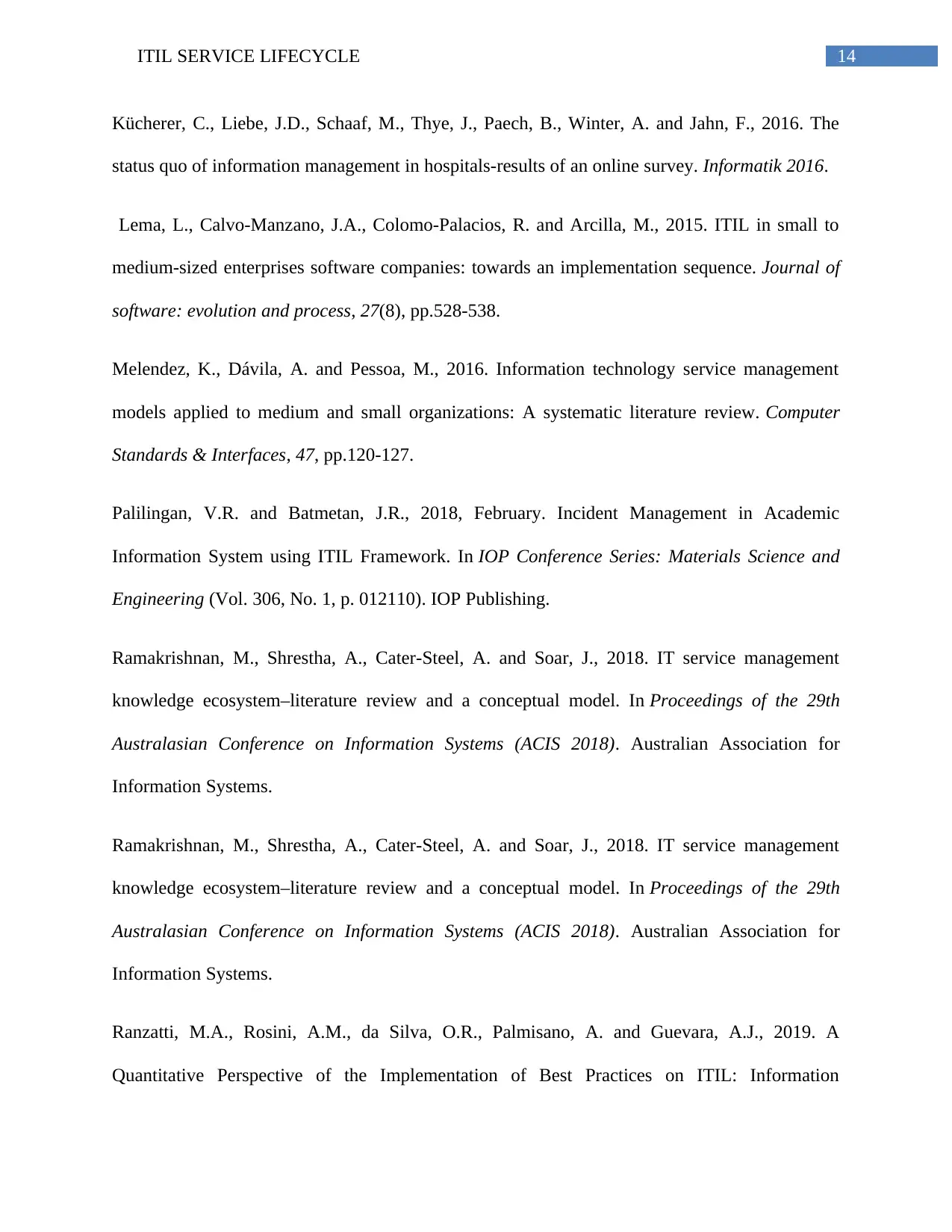
14ITIL SERVICE LIFECYCLE
Kücherer, C., Liebe, J.D., Schaaf, M., Thye, J., Paech, B., Winter, A. and Jahn, F., 2016. The
status quo of information management in hospitals-results of an online survey. Informatik 2016.
Lema, L., Calvo‐Manzano, J.A., Colomo‐Palacios, R. and Arcilla, M., 2015. ITIL in small to
medium‐sized enterprises software companies: towards an implementation sequence. Journal of
software: evolution and process, 27(8), pp.528-538.
Melendez, K., Dávila, A. and Pessoa, M., 2016. Information technology service management
models applied to medium and small organizations: A systematic literature review. Computer
Standards & Interfaces, 47, pp.120-127.
Palilingan, V.R. and Batmetan, J.R., 2018, February. Incident Management in Academic
Information System using ITIL Framework. In IOP Conference Series: Materials Science and
Engineering (Vol. 306, No. 1, p. 012110). IOP Publishing.
Ramakrishnan, M., Shrestha, A., Cater-Steel, A. and Soar, J., 2018. IT service management
knowledge ecosystem–literature review and a conceptual model. In Proceedings of the 29th
Australasian Conference on Information Systems (ACIS 2018). Australian Association for
Information Systems.
Ramakrishnan, M., Shrestha, A., Cater-Steel, A. and Soar, J., 2018. IT service management
knowledge ecosystem–literature review and a conceptual model. In Proceedings of the 29th
Australasian Conference on Information Systems (ACIS 2018). Australian Association for
Information Systems.
Ranzatti, M.A., Rosini, A.M., da Silva, O.R., Palmisano, A. and Guevara, A.J., 2019. A
Quantitative Perspective of the Implementation of Best Practices on ITIL: Information
Kücherer, C., Liebe, J.D., Schaaf, M., Thye, J., Paech, B., Winter, A. and Jahn, F., 2016. The
status quo of information management in hospitals-results of an online survey. Informatik 2016.
Lema, L., Calvo‐Manzano, J.A., Colomo‐Palacios, R. and Arcilla, M., 2015. ITIL in small to
medium‐sized enterprises software companies: towards an implementation sequence. Journal of
software: evolution and process, 27(8), pp.528-538.
Melendez, K., Dávila, A. and Pessoa, M., 2016. Information technology service management
models applied to medium and small organizations: A systematic literature review. Computer
Standards & Interfaces, 47, pp.120-127.
Palilingan, V.R. and Batmetan, J.R., 2018, February. Incident Management in Academic
Information System using ITIL Framework. In IOP Conference Series: Materials Science and
Engineering (Vol. 306, No. 1, p. 012110). IOP Publishing.
Ramakrishnan, M., Shrestha, A., Cater-Steel, A. and Soar, J., 2018. IT service management
knowledge ecosystem–literature review and a conceptual model. In Proceedings of the 29th
Australasian Conference on Information Systems (ACIS 2018). Australian Association for
Information Systems.
Ramakrishnan, M., Shrestha, A., Cater-Steel, A. and Soar, J., 2018. IT service management
knowledge ecosystem–literature review and a conceptual model. In Proceedings of the 29th
Australasian Conference on Information Systems (ACIS 2018). Australian Association for
Information Systems.
Ranzatti, M.A., Rosini, A.M., da Silva, O.R., Palmisano, A. and Guevara, A.J., 2019. A
Quantitative Perspective of the Implementation of Best Practices on ITIL: Information
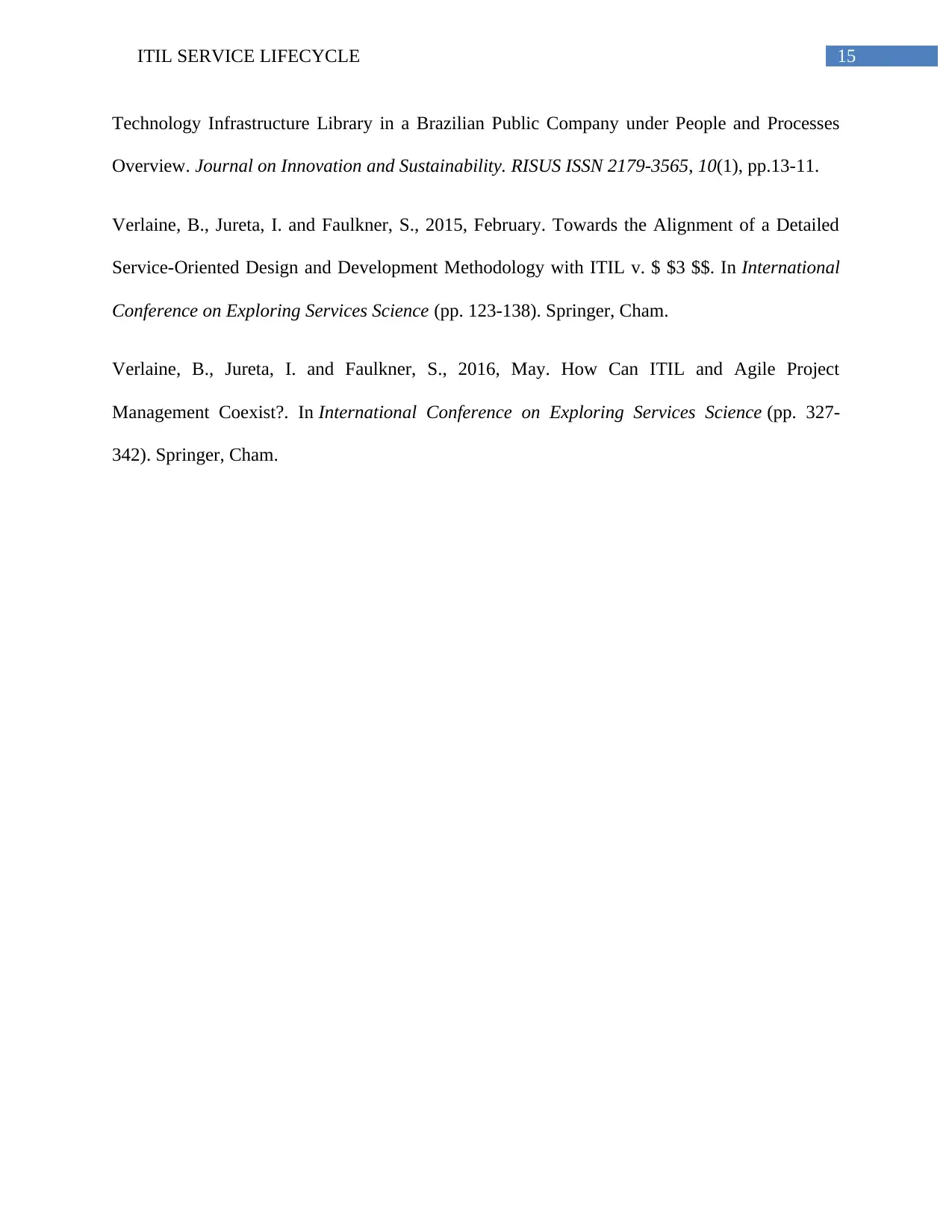
15ITIL SERVICE LIFECYCLE
Technology Infrastructure Library in a Brazilian Public Company under People and Processes
Overview. Journal on Innovation and Sustainability. RISUS ISSN 2179-3565, 10(1), pp.13-11.
Verlaine, B., Jureta, I. and Faulkner, S., 2015, February. Towards the Alignment of a Detailed
Service-Oriented Design and Development Methodology with ITIL v. $ $3 $$. In International
Conference on Exploring Services Science (pp. 123-138). Springer, Cham.
Verlaine, B., Jureta, I. and Faulkner, S., 2016, May. How Can ITIL and Agile Project
Management Coexist?. In International Conference on Exploring Services Science (pp. 327-
342). Springer, Cham.
Technology Infrastructure Library in a Brazilian Public Company under People and Processes
Overview. Journal on Innovation and Sustainability. RISUS ISSN 2179-3565, 10(1), pp.13-11.
Verlaine, B., Jureta, I. and Faulkner, S., 2015, February. Towards the Alignment of a Detailed
Service-Oriented Design and Development Methodology with ITIL v. $ $3 $$. In International
Conference on Exploring Services Science (pp. 123-138). Springer, Cham.
Verlaine, B., Jureta, I. and Faulkner, S., 2016, May. How Can ITIL and Agile Project
Management Coexist?. In International Conference on Exploring Services Science (pp. 327-
342). Springer, Cham.
1 out of 16
Related Documents
Your All-in-One AI-Powered Toolkit for Academic Success.
+13062052269
info@desklib.com
Available 24*7 on WhatsApp / Email
![[object Object]](/_next/static/media/star-bottom.7253800d.svg)
Unlock your academic potential
© 2024 | Zucol Services PVT LTD | All rights reserved.





